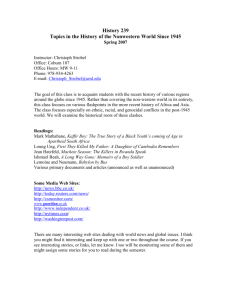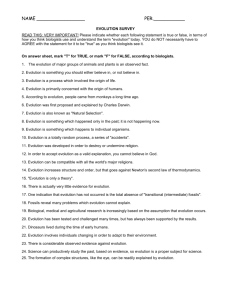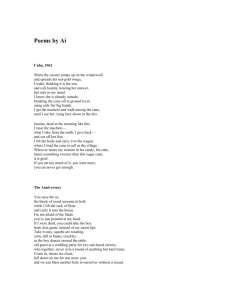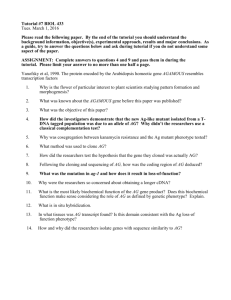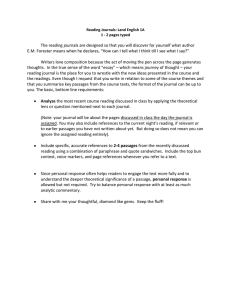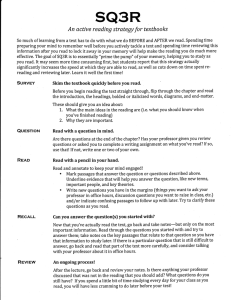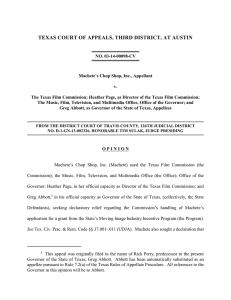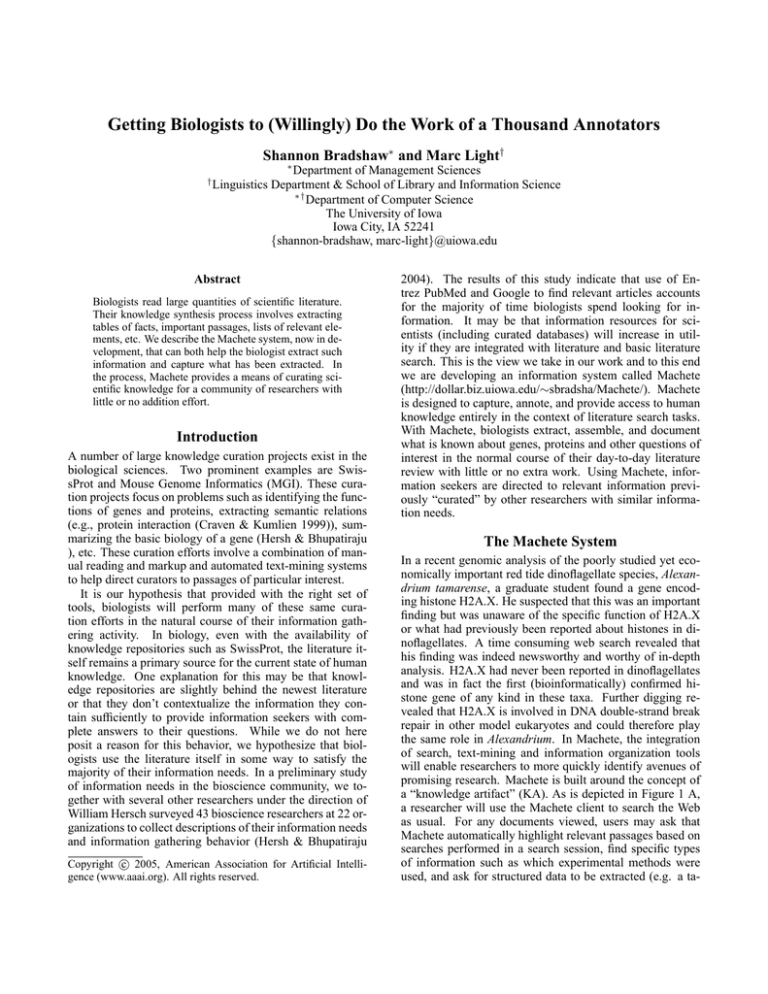
Getting Biologists to (Willingly) Do the Work of a Thousand Annotators
Shannon Bradshaw∗ and Marc Light†
∗
†
Department of Management Sciences
Linguistics Department & School of Library and Information Science
∗†
Department of Computer Science
The University of Iowa
Iowa City, IA 52241
{shannon-bradshaw, marc-light}@uiowa.edu
Abstract
Biologists read large quantities of scientific literature.
Their knowledge synthesis process involves extracting
tables of facts, important passages, lists of relevant elements, etc. We describe the Machete system, now in development, that can both help the biologist extract such
information and capture what has been extracted. In
the process, Machete provides a means of curating scientific knowledge for a community of researchers with
little or no addition effort.
Introduction
A number of large knowledge curation projects exist in the
biological sciences. Two prominent examples are SwissProt and Mouse Genome Informatics (MGI). These curation projects focus on problems such as identifying the functions of genes and proteins, extracting semantic relations
(e.g., protein interaction (Craven & Kumlien 1999)), summarizing the basic biology of a gene (Hersh & Bhupatiraju
), etc. These curation efforts involve a combination of manual reading and markup and automated text-mining systems
to help direct curators to passages of particular interest.
It is our hypothesis that provided with the right set of
tools, biologists will perform many of these same curation efforts in the natural course of their information gathering activity. In biology, even with the availability of
knowledge repositories such as SwissProt, the literature itself remains a primary source for the current state of human
knowledge. One explanation for this may be that knowledge repositories are slightly behind the newest literature
or that they don’t contextualize the information they contain sufficiently to provide information seekers with complete answers to their questions. While we do not here
posit a reason for this behavior, we hypothesize that biologists use the literature itself in some way to satisfy the
majority of their information needs. In a preliminary study
of information needs in the bioscience community, we together with several other researchers under the direction of
William Hersch surveyed 43 bioscience researchers at 22 organizations to collect descriptions of their information needs
and information gathering behavior (Hersh & Bhupatiraju
c 2005, American Association for Artificial IntelliCopyright gence (www.aaai.org). All rights reserved.
2004). The results of this study indicate that use of Entrez PubMed and Google to find relevant articles accounts
for the majority of time biologists spend looking for information. It may be that information resources for scientists (including curated databases) will increase in utility if they are integrated with literature and basic literature
search. This is the view we take in our work and to this end
we are developing an information system called Machete
(http://dollar.biz.uiowa.edu/∼sbradsha/Machete/). Machete
is designed to capture, annote, and provide access to human
knowledge entirely in the context of literature search tasks.
With Machete, biologists extract, assemble, and document
what is known about genes, proteins and other questions of
interest in the normal course of their day-to-day literature
review with little or no extra work. Using Machete, information seekers are directed to relevant information previously “curated” by other researchers with similar information needs.
The Machete System
In a recent genomic analysis of the poorly studied yet economically important red tide dinoflagellate species, Alexandrium tamarense, a graduate student found a gene encoding histone H2A.X. He suspected that this was an important
finding but was unaware of the specific function of H2A.X
or what had previously been reported about histones in dinoflagellates. A time consuming web search revealed that
his finding was indeed newsworthy and worthy of in-depth
analysis. H2A.X had never been reported in dinoflagellates
and was in fact the first (bioinformatically) confirmed histone gene of any kind in these taxa. Further digging revealed that H2A.X is involved in DNA double-strand break
repair in other model eukaryotes and could therefore play
the same role in Alexandrium. In Machete, the integration
of search, text-mining and information organization tools
will enable researchers to more quickly identify avenues of
promising research. Machete is built around the concept of
a “knowledge artifact” (KA). As is depicted in Figure 1 A,
a researcher will use the Machete client to search the Web
as usual. For any documents viewed, users may ask that
Machete automatically highlight relevant passages based on
searches performed in a search session, find specific types
of information such as which experimental methods were
used, and ask for structured data to be extracted (e.g. a ta-
(A)
(B)
Figure 1: (A) Personal information management application (B) Knowledge management system
ble of protein interactions). A researcher may also highlight passages, add margin notes, and otherwise annotate on
top of HTML and PDF documents. Finally, the researcher
may save documents, highlighted passages, extracted information, etc. of his choice in an organized fashion in a KA.
A variety of lenses through which users may view the assembled information will enhance a researcher’s ability to
analyze existing knowledge on a topic of interest. Returning
to our example, Machete will allow researchers to generate
KAs for all genes of interest in a non-model organism so that
these can be rapidly screened for function or distribution to
identify those of the highest interest (e.g., those involved in
DNA packaging or repair as in Alexandrium H2A.X or in
specific metabolic pathways).
This work need never be duplicated. Any KA generated
for a gene in this example, may be reused by the same or
other researchers in other work on that gene. In an information gathering task such as this it is unlikely the graduate student will remember all the genes for which he constructed KAs. Even if he did, another researcher in his
lab probably would not know this and would likely not
think to ask. Machete solves this problem by automatically distributing the KAs created by individuals to other
members of a closed community (see Figure 1 B). Using
a client/server approach, as a researcher begins an information gathering task, his client will begin polling the server
for useful KAs created by other members of his community.
When discovered, the client will inform the user in an unobtrusive just-in-time approach1 (Budzik & Hammond 2000;
Rhodes 2000).
Finally, KAs provide a means by which a group of researchers may collaboratively review the literature on a specific gene and make this information available to the wider
bioscience community. Within a laboratory or other closed
community, KAs will serve as vehicles for information and
knowledge sharing among collaborators. Returning to the
histone H2A.X example, a KA will provide a place to organize and save everything that a research group learns about
1
A just-in-time system works in the background automatically
gathering information that will be useful in the context of what the
user is currently doing. Upon request it provides this information
to the user.
histone H2A.X. Over time a KA will become an extensive
review of the literature concerning a gene family or other
topic of interest. Such KAs will be invaluable resources for
other researchers with related information needs in the same
way as a review article on the subject. Machete will enable researchers to edit annotations and add or remove highlighted passages, figures, documents, or structured information. In the bioscience community of today where review
articles are so important, Machete provides a framework for
generating information that is in effect much like a review
article, but do so in the natural course of literature search
with a fraction of the effort.
Training Data: A Natural Byproduct
A common approach to text processing tasks in bioinformatics is to build a system that can learn from examples that
have been annotated manually. Many of these approaches
make use of statistical machinery (but not all, see (Tanabe &
Wilbur 2002) for a transformation-based learning approach).
More broadly, supervised learning methods are a standard
method in many areas of AI and are likely to play a role
in future AI research. These methods often require large
amounts of supervised data to achieve satisfactory performance. In almost all cases, acquiring such supervised data
is difficult and expensive. This is particularly true in the biosciences, since annotators need graduate degrees to be able
to do the annotation. See (Kim et al. 2003) for an example
of a training data construction project involving bioscience
text.
In using Machete, biologists will naturally generate large
collections of training data for a variety of tasks of importance for text mining research. Named entity annotations,
such as gene names and relations between entities are one
form of output. Typed passages are another. A biologists
will be able to direct the automatic highlighting sub-system
by specifying that he wishes to find passages discussing the
basic biology of a gene, the parameter settings for a methodology, the link between an entity and a disease, etc. Saved
passages resulting from such searches will be associated
with the passage. The biologist can also manually specify
what type of relevance the passage has during the annotation process. Such passages and other markup valuable for
text mining research will be made available to the commu-
nity in well-organized collections of training data with little
extra effort on our part.
User Acceptance
Studies of literature usage in many fields (including bioscience) demonstrate that an article is read approximately
1000 times mostly in the first five years following publication (King & Tenopir 2000). Furthermore, it is a small
percentage of published articles that receive the highest percentage of readings indicating even greater overlap in the
attention of a various communities. Therefore, it is almost
certain that many readers of an article are reading it to satisfy
similar information needs.
People with similar information needs overlap in what
they annotate and the annotations of one individual are of
use to others with similar information needs (O’Hara et al.
1998; Wolfe 2000). Highlighting, underlining, and adding
margin notes on top of existing documents is pervasive in
research-oriented reading and writing activities. Scientists
now perform a majority of their literature search and reading activities on-line (King & Tenopir 2000; AAP 2003;
King & Montgomery 2002; Marshall 2003). It is our hypothesis that the fruits of the information gathering and analysis efforts of one researcher will enable others with similar
information needs to find answers more quickly.
In many small communities such as research laboratories, competitive intelligence concerns are small and individual members will be willing to share the information
they have gathered. Many years of research in knowledge
management indicate that even small work groups (5 to 10
people) benefit from knowledge sharing systems (Rafaeli &
Ravid 2003; Cummings 2004; Allen 1977). Furthermore,
KAs will serve as an important communication tool between direct collaborators, between PIs and graduate students, and between instructors and students in courses they
teach. With regard to broader information sharing with the
the bioscience community as a whole, we hypothesize that
many biologist will be willing to share the fruits of their literature search efforts after publication of the research for
which they collected the information, perhaps as supplementary material cited in the resulting article (see the last paragraph of Section ).
Summary
The volume of scientific knowledge in the biological sciences in enormous and increasing rapidly. This situation
demands tools that effectively organize human scientific
knowledge. While useful tools such as SwissProt exist and
are used by biologists, researchers continue to use the literature as their primary source of information. We hypothesize that knowledge management tools for bioscience can
and should be integrated with regular literature search activity. The Machete system, now in development, helps biologists assemble answers to specific research questions from
the literature and curates such answers for future use by the
same or other researchers. Machete has the additional benefit that it will also provide large collections of training data
for many areas of text mining research. Many studies of
literature search, reading, and annotation behavior indicate
that our approach is sound and may provide a means of curating human scientific knowledge without the need for fullor even part-time curators.
References
AAP. 2003. Report on the association of american publishers - professional and scholarly publishers 2003 conference. Scholarly Information Strategies, Ltd.
Allen, T. 1977. Managing The Flow of Technology. Cambridge, MA USA: MIT Press.
Budzik, J., and Hammond, K. J. 2000. User interactions
with everyday applications as context for just-in-time information access. In Proceedings of IUI.
Craven, M., and Kumlien, J. 1999. Constructing biological knowledge bases by extracting information from text
sources. In Proceedings of ISMB.
Cummings, J. 2004. Work groups, structural diversity and
knowledge sharing in a global organization. Management
Science 50(3).
Hersh, W. R., and Bhupatiraju, R. T. TREC 2004 genomics
track overview. In Proceedings of TREC.
Hersh, W. R., and Bhupatiraju, R. T. 2004. TREC 2004
genomics track overview. In Proceedings of TREC.
The
2003
biocreative
evaluation.
www.pdg.cnb.uam.es/BioLINK/BioCreative.eval.html.
Kim, J.-D.; Ohta, T.; Teteisi, Y.; and Tsujii, J. 2003.
Genia corpus - a semantically annotated corpus for biotextmining. Bioinformatics 19(suppl. 1).
King, D. W., and Montgomery, C. H. 2002. After migration
to an electronic journal collection. D-Lib Magazine 8(12).
King, D. W., and Tenopir, C. 2000. Towards Electronic
Journals: Realities for Scientists, Librarians, and Publishers, volume 22 of Special Libraries Association. Special
Libraries Association.
Marshall, C. C. 2003. Reading and interactivity in the digital library: Creating an experience that transcends paper. In
Proceedings of the CLIR/Kanazawa Institute of Technology
Roundtable.
O’Hara, K.; Smith, F.; Newman, W.; and SelIen, A. 1998.
Student readers’ use of library documents: Implications for
library technologies. In Proceedings of CHI 1998.
Rafaeli, S., and Ravid, G. 2003. Information sharing as
enabler for the virtual team: an experimental approach to
assessing the role of electronic mail in disintermediation.
Information Systems Journal 13:191–206.
Rhodes, B. 2000. Just-In-Time Information Retrieval.
Ph.D. Dissertation, MIT Media Lab.
Tanabe, L., and Wilbur, W. J. 2002. Tagging gene and
protein names in biomedical text bioinformatics. Bioinformatics 18(8).
Wolfe, J. L. 2000. Effects of annotations on student readers
and writers. In Proceedings of Digital Libraries 2000.

